
Return
to Breed Profiles Main Page Montana TravlerBy Rhonda Hart PoeThe Big Sky Country boasts vast expanses of raw, unspoiled territory. Beautiful, but brutal, this land has always demanded the best of both man and beast just to survive - only the truly exceptional excel. 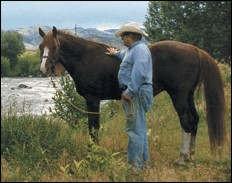
IN THE 1930S AMONTANA COWBOY named Tom Eaton was given a mare that was half Thoroughbred, half Hamiltonian Standardbred. For several years, she was bred to a Standardbred stallion named Muggs, who was also of the Hamiltonian line, and produced good quality foals. In 1939, this mare and several of her offspring were crossed with the American Saddlebred stallion, FORCED MELODY. Those breedings also produced good foals. In 1940, Eaton purchased a half-Morgan, half-American Saddlebred stallion from the Millers of Billings, MT and from 1942 to 1946 used this stallion who was noted for putting "saddlebacks" on his babies. During that time, Eaton served in WWII and returned in 1946 to 45 young horses that needed to be broke to saddle. None of them bucked. Given the differences in horsemanship in that time and place as compared to expectations these days, that was a strong indication of the gentle nature of the horses he had bred. He knew he was onto something. Tom augmented his living by taking the well-to-do on guided mountain trail rides over the mountain from Yellowstone Park. He took kids on camp rides and learned from living with horses and inexperienced horsemen the attributes it really took to make a reliable trail mount. Anything that kicked, bit or couldn't make the trip was cut from the string. He became very knowledgeable. Tom's other passion was education. Both his father and uncle had a boy's club and a girls' club, and were co-founders of Rocky Mountain College. The family was very involved with the community. Not surprisingly, young Tom followed suit and entered the teaching profession, eventually becoming a principal, all the while still working cattle and raising his own horses. In the late 1940s, Tom purchased the Morgan stallion HIGHLAND STAR who sired foals for the next six years. A Thoroughbred stallion and Tennessee Walking Horse stallion were also used. This mix of bloodlines was carefully monitored and culled, with only the most promising foals being kept to continue on with what was becoming Tom Eaton's legacy. The Montana Travler is the result of not only a great stallion, but selective breeding over a period of many years. -Tom Eaton In 1973, two mares from Eaton's evolving line were crossed with the Tennessee Walking Horse stallion, COLDWELL'S PAT. So it was that after nearly 40 years of raising horses, looking for the best qualities and trying to combine them, he found them all in one special colt. This colt, MONTANA TRAVLER, had that standout quality that demanded the attention of area horsemen. As a two-year-old, in 1977, this colt sired his first four foals, and all showed that same stamp of quality. It was clear Tom's work had just begun. MONTANA TRAVLER matured into a flashy 16+ hand, bright sorrel stallion who could "walk" at eight miles per hour with an overstride of eight inches or more. Trained as a three-year-old by Don McClurg, a local trainer and "Quarter Horse man", the Travler was deemed to also have remarkable cow sense. That running walk gait, along with significant endurance, cowiness and a kind, sensible disposition are the trademarks of the Travler's descendants. They are among the most prized horses of both working class horsemen and pleasure riders in an ever-widening area throughout Montana and neighboring North Dakota.
With the encouragement of his friends and horse buying customers, Eaton set up a breed registry and association in 1979 for the breed he named, Montana Travler. Only horses proven to trace to MONTANA TRAVLER, that also meet the criteria of con-formation, gait, soundness and most importantly, a good mind, are eligible to be registered. Registration requires the horse to be exhibited under saddle, and approved and signed by three directors of the Montana Travler Horse Association. The look of the breed shows some of that early Morgan blood, but with a bit more length. A narrow, but deep chest is preferred. The typical Montana Travler has tremendous lung capacity and can attribute its great endurance to very efficient oxygen-to-energy conversion. They have a long hip and are remarkable for a good top line and "saddle back". Sound conformation, gentle willing disposition, strong feet, running walk gait, and proven stamina under work are all business as usual for these horses. They are also known for being surefooted in difficult terrain. Says Mel Atkinsen, a breeder with a large gene pool of Travler horses, "These horses move like they are walking over deadfall. They pick up real well, and watch where they place their feet." But there's more to these horses than good feet. Mel adds, "Mr. Tom wasn't a bragger, but he'd say if you want an excellent saddle horse, come to the mountains of Montana and buy one out there. When foaled, if they don't fall in a hole, fall or break a leg, or if the cougars don't get 'em, the smart ones are gonna survive." Mel discovered the Montana Travler through a newspaper article. "After reading that article, I just had to visit. It was the type of horse I had always envisioned," he remembers. "I spent quite a bit of time at Tom's ranch." What impressed Mel most were Tom's criteria , "They had to have 1, a mind, and 2, good feet, but Tom always said it doesn't matter much which is #1 or #2. You could have the prettiest horse, but if you don't have 1 or 2, you don't have a horse at all." Mel explains that Tom's ranch was situated at an elevation above 5,000 feet. "The horses might have to work at elevations of 7000 to 8000 feet all day and do it again tomorrow." The descendents of MONTANA TRAVLER usually bear his unmistakable likeness. Mel comments, "If they come to me and want to be touched, and are not afraid, if they are chestnut with a blaze face and socks, they'll be 100% Travler. You can also see the conformation, the long hip, deep chest and after about two, a good set of withers."
It was not Tom Eaton's intention to start a new breed. He is remembered as a low profile man. "Not after glory, very modest," Mel says. Probably the thing that most impressed him was Eaton's pragmatic philosophy. "He didn't believe in horse shows. The only "horse show" he believed in was bringing a horse out to the ranch and testing them in the mountains. 'Show me what he can do', Mr. Tom would say," Mel fondly remembers. For information contact: The state of Montana recognized the Montana Travler as an official Centennial Horse in 1989.
(Special thanks to Grace Larson of the Part Walking Horse Registry this
information.)
|
|||||||||

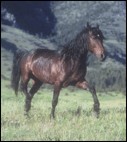
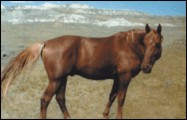
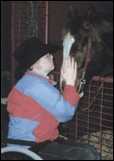
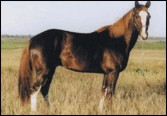 Mel Atkinsen had a mare bred to the MONTANA TRAVLER son SILENT SYE and was
presented with a very nice stud colt, and a dam without enough milk. The foal
didn't even receive colostrum, so was whisked to a vet in Dickenson, North
Dakota, who was knowledgeable about orphans. He received blood serum from a
donor horse and was returned home where he quickly learned to sneak milk from
another nursing mare. "He was a survivor," says Mel. This year, that foal will
be seven years old. Mel is now the proud owner of both SILENT SYE, and his moxy
son, DAKOTA FLASH.
Mel Atkinsen had a mare bred to the MONTANA TRAVLER son SILENT SYE and was
presented with a very nice stud colt, and a dam without enough milk. The foal
didn't even receive colostrum, so was whisked to a vet in Dickenson, North
Dakota, who was knowledgeable about orphans. He received blood serum from a
donor horse and was returned home where he quickly learned to sneak milk from
another nursing mare. "He was a survivor," says Mel. This year, that foal will
be seven years old. Mel is now the proud owner of both SILENT SYE, and his moxy
son, DAKOTA FLASH.